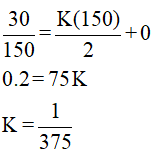A test leaf filter is used to determine the filtration rate for an unclarified broth from a fermentor. At a pressure drop of 50 kPa, 150 mL of filtrate are collected in 30 minutes. If the resistance of the filter cloth is negligible, will 300 mL of filtrate be collected in 30 minutes if the pressure drop is doubled? If not, how many mL of filtrate will be collected?
A test leaf filter is used to determine the filtration rate for an unclarified broth from a fermentor. At a pressure drop of 50 kPa, 150 mL of filtrate are collected in 30 minutes. If the resistance of the filter cloth is negligible, will 300 mL of filtrate be collected in 30 minutes if the pressure drop is doubled? If not, how many mL of filtrate will be collected?
The amount of filtrate collected if the pressure drop in the given conditions is doubled is to be determined.
The equation for the filtration is given as,
 ....... (1)
....... (1)
The notations in above equation are,
t = Time of filtration
V = Volume of the filtrate collected
C = 1/q
q = Flow rate
The K in equation (1) is given as,
 ....... (2)
....... (2)
c = Mass of cake deposit per unit volume of filtrate
A = Area available for filtration
 = Specific cake resistance
= Specific cake resistance
 = Viscosity of fluid
= Viscosity of fluid
 = Pressure drop
= Pressure drop
The data given for first condition is,
t = 30 min
V = 150 mL
For negligible filter cloth resistance, C = 0.
Thus, from equation (1),

Step by step
Solved in 7 steps with 8 images









